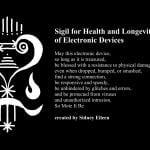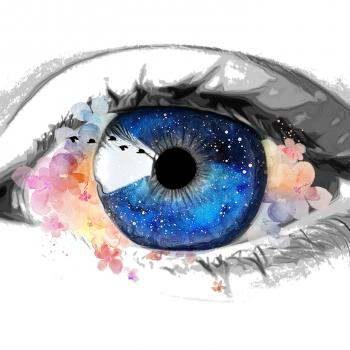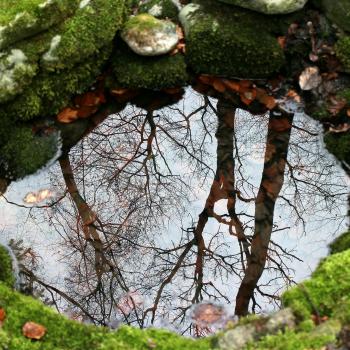Most of the people I know and am friends with own at least one set of role playing dice, if not multiple sets in various colors and made from various materials. It is possible to use magic to nudge the odds when rolling dice, but they are useful for so much more than that! From spellcrafting to divination (called astragalomancy), dice magic is a fun and useful tool to keep in your witch’s kit. After all, unconventional magical tools are just as valid as typical or traditional ones.
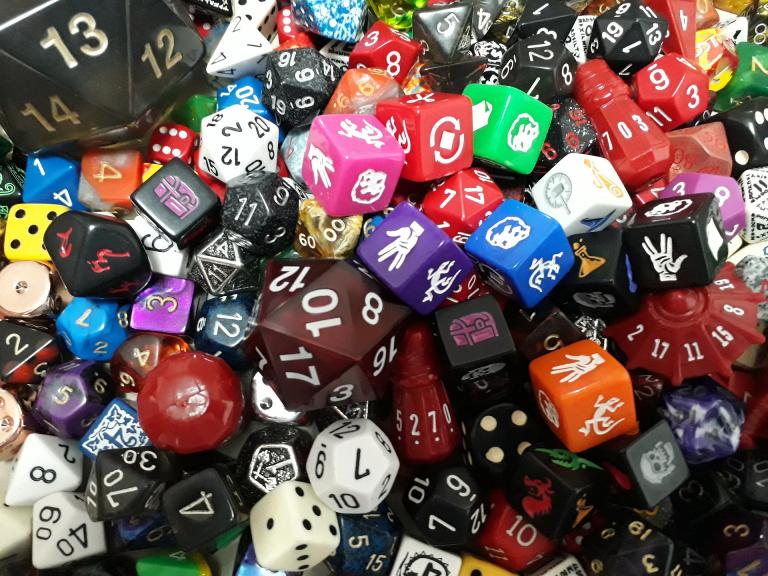
I am going to assume that not everyone reading this article is familiar with tabletop RPG’s (Role Playing Games), so if you are, please bear with me as I explain some basic concepts about dice in general, and how they are most often used in tabletop gaming. I lean heavily on RPG associations because those are my strongest associations with dice, and I am delighted to get to nerd out about RPG’s and how their systems can be applied to real magic. If you have other associations that inspire you to use your dice in different ways, go for it!
Types of Dice
There are an absolutely dizzying array of dice available today. They range from rather boring six siders with pips (dots) on each side, to hand-crafted works of art with complex images created within the body of the dice themselves. Plastic and epoxy resin dice are by far the most common, but dice are also made from stone, gemstone, wood, metal, bone, ceramics, glass, and more. If you are so inclined, you can even purchase a set of epoxy resin dice molds and make your own set.
The main way to refer to dice is by the number of sides it has. You can sometimes find the rare die with sides numbering 3, 16, 24, 30, 50, or even 100 (yes, I did at one point own a true 100-sided die, and no, it did not work very well), but most dice are going to be D4, D6, D8, D10, D12, or D20 (“D” for “dice” + the number of sides). That is because those are the sizes used most often for tabletop RPG’s, and gamers are the largest market for dice sets. In fact, when you are looking to buy dice, “dice set” by default means an RPG set with a range of dice sizes. If you want a dice set for a specific board game like Yahtzee, you must ask for the game or specific dice by name.
Dice of all types are available for individual sale online or in gaming and comic stores, but they are also available in sets. A good set is usually going to have 1D4 (one four-sided die), 1D6, 1D8, 2D10, 1D12, and 1D20. You need 2D10 in order to roll for 100, with one die representing the ten’s digit, and the other representing the one’s digit. So, if your ten’s digit die rolls a 2, and your one’s digit die rolls an 8, your D100 roll is 28.
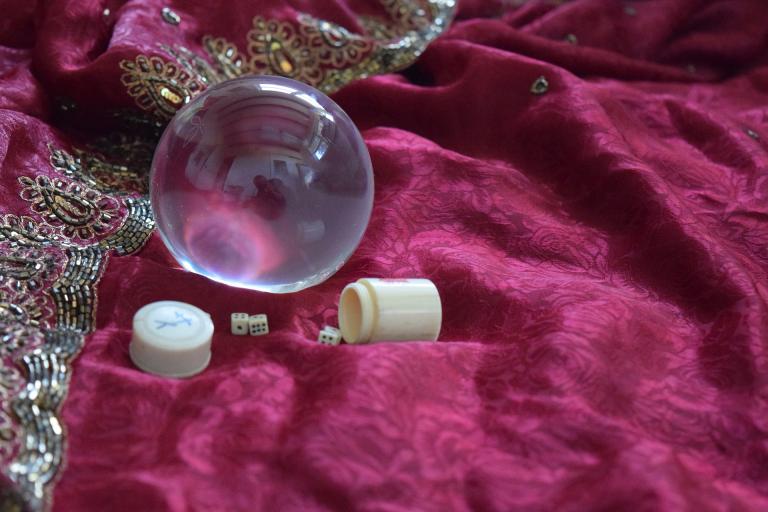
The most common type of dice for gambling and boardgames are D6 dice with pips on the sides. The number of pips indicates the value of that side. Six-siders can be found in a delightful array of novelty forms, from dice the size of a pinhead, to cliché fuzzy dice to hang on your rear-view mirror. If what makes the die quirky or novelty holds symbolic or personal meaning for you, then that extra layer of meaning can be applied to magic.
Hand-crafted dice can come in just about any material, and some of them are stunning works of art. The price you pay for them usually reflects the materials cost and time spent creating the dice, but it is an option if you want a unique set of dice, or dice made out of a specific material. Some hand-crafted dice are even made with occultists in mind, using runes, ogham, planetary symbols, knotwork, or other symbols or sigils on the sides instead of numbers. If you want something truly unique to suit your practice, it may even be possible to commission a dice artist for a set of dice to exactly your specifications.
Since dice come in literally every color, and a wide variety of materials, it is possible to have magically charged or consecrated dice that are also sympathetic via color magic or material symbology.
Weighted and Imperfect Dice
Professional gambling pipped dice can be found, but they are pricey. They are designed to exacting standards so the die will not be weighted, and has a completely even chance of landing on any side.
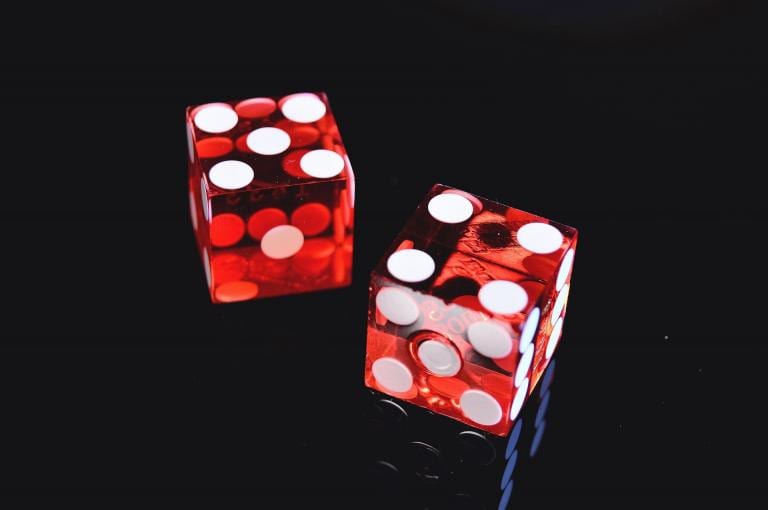
Most dice will have manufacturing imperfections that cause them to roll less than perfectly, and even the difference in weight on each side created by carving numbers and symbols does have a statistical impact on rolls. Fancy carvings and sculpting, potentially even more so, especially if the sculpting and carving is not completely consistent around the die. Most of the time you will not see that difference unless you statistically track your die for thousands of rolls, but when you get a new die it is worth giving it a bit of a test run to see if it is glaringly weighted or imperfect. Just roll it a couple dozen times, focusing on letting it fall where it naturally wants to, and see if you get results fairly evenly around the whole die.
If you find that your die is slightly weighted, I do not recommend using it for role playing (sometimes the missteps make for great storytelling). However, it may be perfect for use in spellcrafting, especially if you really like the aesthetic of the design. Just be sure to keep in mind what numbers it wants to fall on the most frequently.
Dice Trays
Dice trays are a phenomenon among those who use dice regularly, because they keep your dice from rolling right off the table (If I had a dollar for every time I had to chase down an errant die…). Basically, a dice tray is any tray that has steep sides at least 1” high. They are typically anywhere from 6” to 18” across. Fancy ones are often made out of leather, but they can be made out of anything. Even deep box lids will work.
Fancy and plain dice trays are available for sale. Like the dice themselves, most are mass-produced, but there is also a community of artists that craft them by hand, or even take commissions. It is also relatively easy to make one yourself if you are crafty, or to repurpose a sturdy box lid, platter, serving tray, or decorative tray, provided that it has steep sides.
For purposes of magical use, a dice tray is going to be a lot like having a large offering plate, altar cloth, or tarot cloth. It is not necessary, but it can be very useful for both practical and magical reasons. Exactly what it is made out of, and what decorations it has will depend upon your personal taste, practice, budget, and the intent of your use of dice in your practice. There is no right or wrong answer.
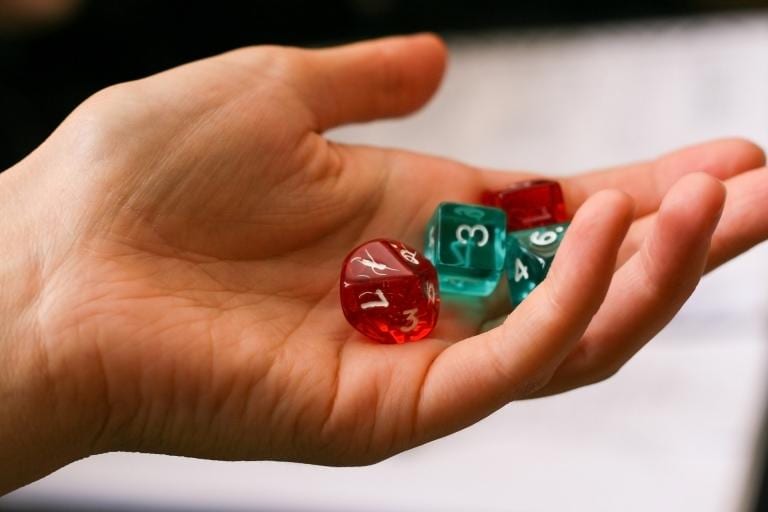
Throwing Dice
I throw dice with my hands. Some people or traditions might be particular about what hand, or using a cup, or throwing right out of the bag. You can shake it a particular number of times, blow on it, show it to your patron deity, etc. If you have a reason for doing it a particular way, do it that way. There is no wrong or right way to throw your dice, as long as it makes sense to you within your practice.
Dice Magic and Dice Spellcrafting for the Tabletop RPG Player
Magic works on symbology and intent. If a thing represents something to you, then you can use that symbolic representation to power your magical intent. For anyone who has played tabletop RPG’s, the symbology of rolling a D20 is practically etched in stone.
Most tabletop RPG’s are based on a D20 for determining the outcome of any action or event. A high roll is generally good, with a natural 20 representing a critical hit or spectacular success. A low roll is generally bad, with a natural 1 representing a death blow or spectacular failure. “Natural” means the number that comes up on the die when you roll it, before any modifiers are applied.
Most rolls will have a modifier, based on skill level or advantages that are at play. So, if for instance a character wanted to perform a dance, the first modifier would be their skill level. A highly skilled dancer would have a bonus, and someone who had never danced before would potentially have a penalty. Other factors, like an uneven stage, ill-fitting shoes, or a hostile audience, might modify the roll further. The modifiers are added or subtracted from the roll in order to provide the number that represents how well the character does when dancing. Most of the time I feel that anything over a 10 represents a success, and anything under represents failure. The closer it is to 20, the better the success. The closer to 1, the worse the failure. The closer to 10, the more mediocre the result or closer the call (just barely missed it, or just barely made it).
For that reason, I am mostly going to refer to using D20’s, but a high roll on any die is usually considered more successful. If all you have are pipped D6’s from a board game, the 6 would represent success, and the 1 would represent failure, with the rest scaling in between.
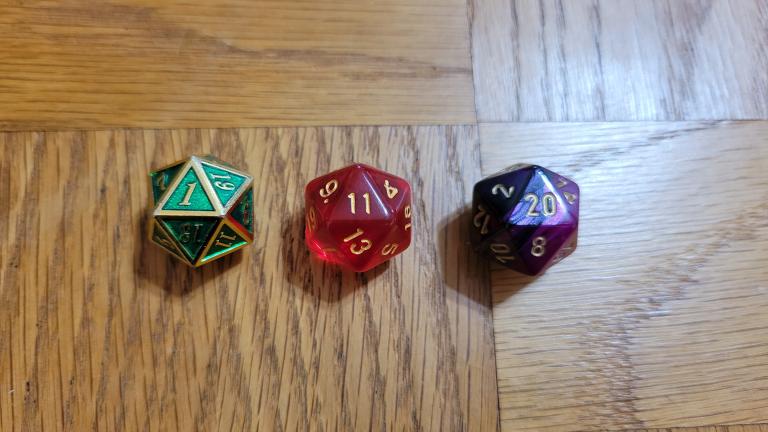
Rolling for Successful Magic
What that means is, that you can use the symbology of high rolls to empower spells in a positive or successful direction. It really does not matter what the spell or its intent is. If you are looking for success, a high roll on a D20 represents that success. A natural 20 represents spectacular success. If you are working a spell, it is likely that you want a successful outcome, otherwise you probably would not be bothering.
You can add that D20 to your altar as an additional ingredient empowering your spell. I am going to describe two main ways to do that, but if you think of another use that makes sense to you, go for it! What matters most in your magic is that it makes sense for you, not someone else.
Method 1 – Set the Die
In this method, when you are setting your intent and fully focused on success, deliberately set the die on your altar with a high number facing up. On a D20, I recommend either 19 or 20, depending upon whether you want to emphasize general success, or spectacular success.
If you use a 19, focus on how easy it is to set the die to a successful number. Your magic should follow that easy path and find its way to success.
Putting the 20 up requires a bit more care. Consider carefully if spectacular success is particularly unlikely or even impossible, because unrealistic expectations may cause your entire spell to fizzle out and fail. If spectacular success is unlikely, but not impossible, focus on wanting the spell to be a solid success, but it would be fantastic if it really did come up a 20.
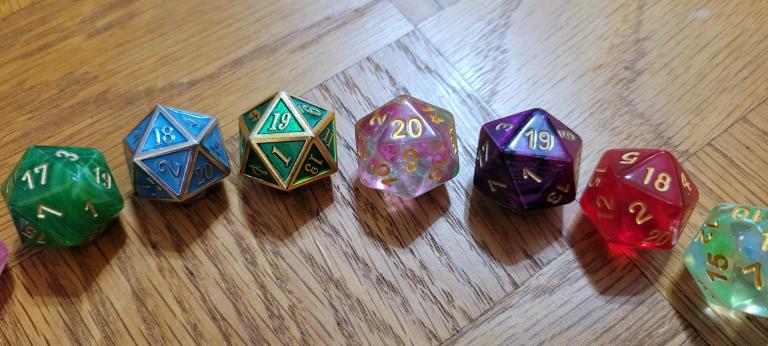
Method 2 – Rolling the Die
Setbacks, stumbles, stagnancy, and missteps are a natural part of just about any process, especially if you are working towards goals over time. Even when an upward trajectory is the most visible path, there are going to be occasional plateaus and dips. Rolling the die brings into the magic an awareness and acceptance of those difficulties and doldrums, and emphasizes flexibility and perseverance over immediate success.
I do recommend using a dice tray or offering bowl to roll your die in, especially if your altar is small, crowded, or has delicate or flaming objects on it (candles, incense, etc.). Also, roll gently so you do not bounce the die right out of the tray (practicing a few times away from the altar to see how it rolls in your chosen tray is entirely reasonable). It would not do to set your altar on fire or break a sacred object when you work your spell.
When you are ready to set your intent and focus on success, pick up your die and roll it. If it comes up a low number, focus on the fact that setbacks do not define the outcome. You can and will ride them out. Roll it again, and again, and again, until you arrive at a high number that is successful.
Some divination can come into play with this method, with the various rolls representing real trials that you will face in accomplishing your goals. For that reason, be careful if you decide a successful roll is not “good enough”, and so roll again. It may be reasonable to set the bar high and keep working until you hit a lofty goal, or you may be setting yourself up for missed opportunities at success that will keep you grinding away longer than you need to or want to.
It can be worthwhile to decide beforehand how high of a roll you need for your goal. Like with rolling dice in an RPG, if everything is already in your favor, a roll of only 11 or 12 may get you where you want to go. If there are some obstacles, 15 or 16 may be more appropriate. If it is important that everything turn out very well, or it is expected to be difficult, 19, 18, or even 17 will get you there. Be vary careful about insisting on a 20. Spectacular success is generally a rare thing, and an ordinary good success is usually more than sufficient to win the day. Like Icarus flying too close to the sun, you might just burn yourself insisting on perfection or aiming recklessly high.
However, if you do roll a 20, especially in the first few rolls, I would take that as a very good sign indeed.
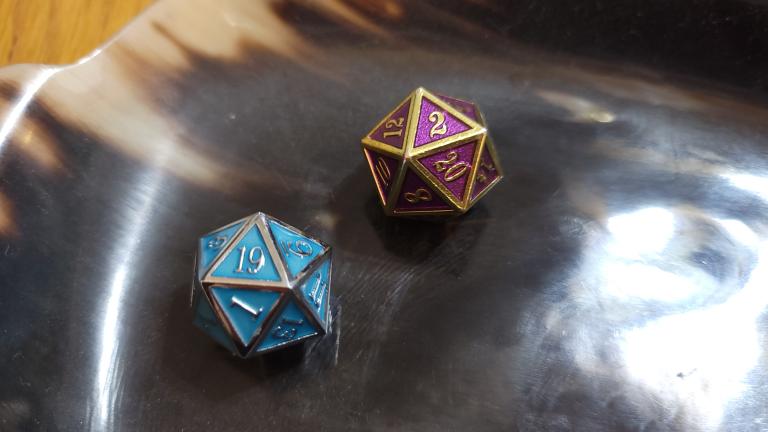
Rolling for Baneful Magic, Banishing, or Counterspells
If your intent is on the more baneful or banishing end of the spectrum, it might make sense to want a low roll. But this approach does require a particular mindset. In RPG’s, someone always has to roll for the antagonist, but as a player, you usually want that antagonist to roll poorly. The more poorly they roll, the easier it is for the player to be successful against them. That means that there are times when you are hoping for the low roll, but those situations are usually antagonistic or confrontational in nature.
Say, for example, you want to undo some magic that was previously woven. Yours or someone else’s does not matter. In order to be successful at undoing it, you need that existing magic to fail and dispel. Since a low number represents failure, if you are rolling for the existing magic, you want the die to show a low number. To give it extra oomph, you can even use two dice, one that represents your efforts (go high), and one that represents the existing magic (go low).
If you are wanting to conduct baneful magic, you can use the same principle, drawing upon both baneful and blessing energies within the same spell. The target of the baneful magic gets a low roll, and your efforts get a high roll.
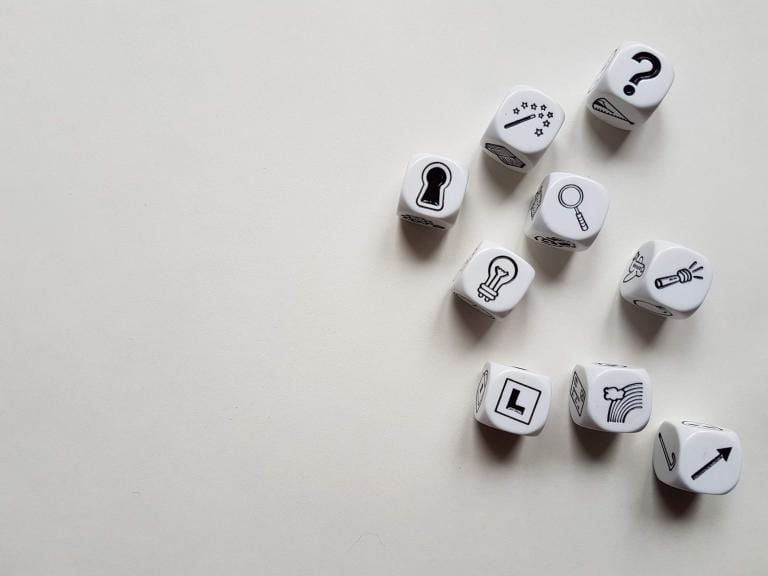
Using Dice Without Numbers
As I mentioned above, you can get dice with symbols other than numbers on them. Exactly how many sides the dice will have depends upon the system the symbols come from, and the whim of the maker.
Some of the easiest pictographic dice to find are going to have symbols related to specific games. If you are familiar with those games and the nuances of what those symbols represent, you can use them in your spellwork or divination.
Other dice that are available will have occult or cultural symbols on them. Some of the ones I found had runes, ogham, planetary symbols, astrological symbols, knotwork, or “spooky” drawings. And, of course there are the oddball dice that do not seem to fit in anywhere, that have seemingly random images inscribed on them once divorced from their source. I suspect most of those come from defunct games, promotions, novelty shops, or joke shops. Regardless of the specific images, if they have meaning to you, you can use them as a sympathetic link in magic, or find meaning in them when doing divination.
Using Dice in a set of Bones
Throwing bones is a specific kind of divination that is based on throwing found or created objects. These objects may be wildly disparate, and can seem random to an onlooker, but each has very specific meaning to the person using them. They are called “bones” because of historic associations, and because most people who use this form of divination will have at least a couple bits of bone or teeth in their divination bag (at least, that has been my experience).
The seer will usually have a cloth with a circle or other border on it, which the bones are thrown onto. The items that fall inside the circle or border are the ones that apply to the current reading. Their individual meanings and how they fall in relation to each other and any imagery on the cloth are used to intuit the message of the reading.
Since collecting a set of bones for divination is highly personal, literally anything small and durable can end up in the set. It is not unreasonable to throw a particularly special die or two into the bag, if you are so inclined.
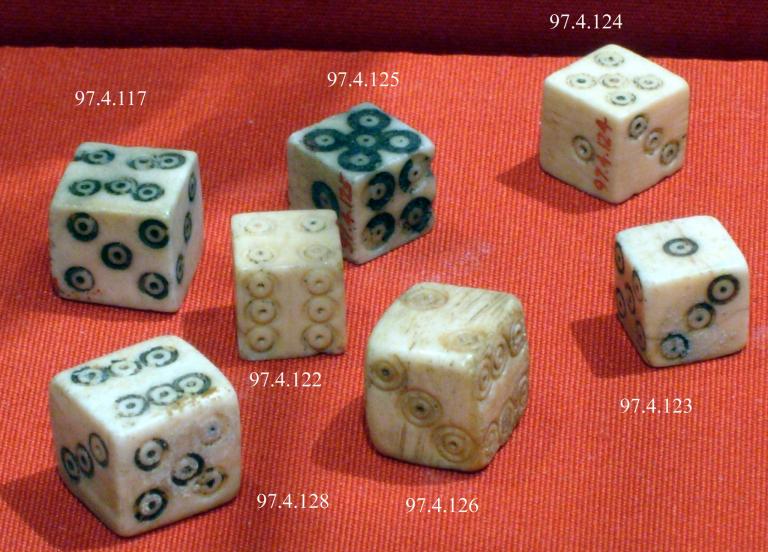
Astragalomancy – Divination with Dice
I have mentioned before that just about anything can be used as a tool for divination, and dice are no exception. I must warn you that I am NOT an expert in astragalomancy, but I feel it is important to mention, and I do have some thoughts and suggestions for where to start if you are interested in pursuing this particular form of divination.
All mentions of astragalomancy that I could find online recommended throwing the dice onto a cloth with a circle drawn on it, just like when throwing bones. Dice that fall within the circle are read, and ones that fall outside the circle are omitted from the reading. This is particularly unsurprising to me since most of these sources also indicated that the first “dice” used for astragalomancy in the Mediterranean and Near East were made out of knuckle bones that had been inscribed.
None of the material I looked at mentioned reading the locations of the dice on the cloth, but as someone who once had a set of bones, I cannot help but think that where the dice fall may be important. If that idea makes sense to you, closer to the center would mean greater influence or import, and further from the center indicates lower influence or import. Dice that fall close to each other are likely to interrelate or directly influence each other, like a tarot card that is placed across another card. If there is artwork or symbols on the cloth other than the border, proximity to those can also be read into the meaning.
If you are already familiar with a symbolic system that is available in dice form, that may be an excellent place to start. For example, if you are familiar with astrology, dice with astrological symbols may work very well for you. Same for runes, ogham, planetary symbols, or symbols associated with a gaming system.
If you are familiar with numerology, those principles can easily be applied to astragalomancy. This may be as simple as adding up the numbers on the dice or making other numerological calculations. Additionally, you can use color associations to assign different areas of influence to different colored dice, or keep in mind special associations you have with dice with a particular number of sides. In other words, if the green die with gold numbers represents physical aspects of the query, the numerology of its result will apply to physical aspects. If your D8 represents fortune and luck, the numerology will tell you about fortune and luck aspects.
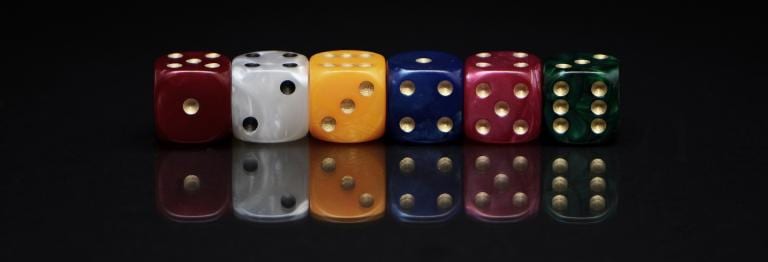
I also found a couple different rigid interpretation guides for astragalomancy for throwing one or two six-sided dice, but I am not going to link to them because I am wary of rigid divination meanings. Generally, I find that situations we want divination about are not so clean-cut. If you want to find them yourself, a quick Google search on astragalomancy should bring them up.
Do Not Forget to Play
Even though we can use them for magic or divination, dice are, at heart, all about play. The more you play with them, the more you will understand what they represent, and how you can most effectively use them for more serious work. After all, play is a wonderful way to build your skills and your relationship with your dice, and we could all use more fun in our lives.

